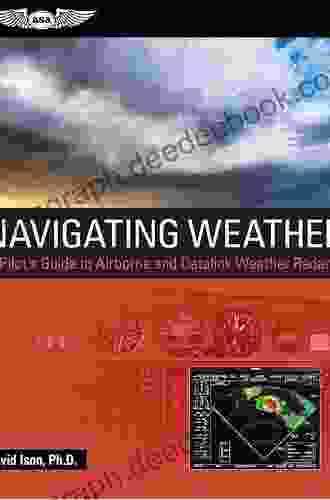Pilot Guide to Airborne and Datalink Weather Radar: A Comprehensive Overview

Weather radar plays a crucial role in modern-day aviation, providing pilots with real-time information about weather conditions ahead, allowing them to make informed decisions and enhance safety. This article serves as a comprehensive guide for pilots on airborne and datalink weather radar, covering their principles, capabilities, limitations, and best practices for use.
Airborne Weather Radar
Principles
Airborne weather radar operates on the principle of electromagnetic wave reflection. It transmits pulses of energy at specific frequencies towards the atmosphere and analyzes the reflected echoes to determine weather phenomena such as precipitation, turbulence, and lightning. The reflected energy is measured by an antenna and converted into electrical signals that are processed and displayed on a cockpit display.
4.2 out of 5
| Language | : | English |
| File size | : | 22805 KB |
| Text-to-Speech | : | Enabled |
| Screen Reader | : | Supported |
| Enhanced typesetting | : | Enabled |
| Print length | : | 299 pages |
| Lending | : | Enabled |
| Item Weight | : | 1.01 pounds |
| Dimensions | : | 5.55 x 0.79 x 8.5 inches |
Types
There are three primary types of airborne weather radar:
- Doppler Weather Radar: Detects the velocity and direction of precipitation particles, providing additional information about wind shear and turbulence.
- Pulse-Doppler Weather Radar: Combines Doppler and pulse radar principles, offering enhanced sensitivity and resolution.
- Solid-State Weather Radar: Uses solid-state technology, eliminating the need for vacuum tubes, reducing weight and improving reliability.
Capabilities
Airborne weather radar provides versatile capabilities, including:
- Precipitation Detection: Identifies and quantifies precipitation intensity, including rain, snow, and hail.
- Turbulence Detection: Indicates potential areas of turbulence, helping pilots avoid uncomfortable or dangerous conditions.
- Lightning Detection: Detects the presence of lightning activity, allowing pilots to maintain a safe distance from thunderstorms.
- Wind Shear Detection: Determines wind velocity and direction changes, providing advance warning of hazardous wind shear conditions.
Limitations
While airborne weather radar is a valuable tool, it has certain limitations:
- Attenuation: Heavy precipitation can block or weaken the radar signal, reducing its effectiveness.
- Ground Clutter: Reflections from the ground can interfere with radar data, making it difficult to interpret weather information near or on the ground.
- Limited Range: Airborne weather radar typically has a limited range, which may not provide sufficient coverage for long-range flights.
- Vertical Scanning: Most airborne weather radar systems have limited vertical scanning capabilities, potentially missing weather information at higher altitudes.
Datalink Weather Radar
Principles
Datalink weather radar is a satellite-based system that provides pilots with real-time weather information transmitted directly to their aircraft via a data link. It receives and displays radar data from ground-based weather radars.
Capabilities
Datalink weather radar offers several capabilities:
- Extensive Coverage: Provides broader coverage than airborne weather radar, including areas beyond the aircraft's line of sight.
- High Resolution: Typically delivers higher resolution data than airborne weather radar, improving accuracy and detail.
- Vertical Scanning: Offers continuous vertical scanning, providing comprehensive information about weather conditions at various altitudes.
Limitations
Datalink weather radar also has some limitations:
- Latency: Data can have a slight delay, potentially affecting situational awareness in rapidly changing weather conditions.
- Data Availability: Availability of datalink weather radar services may vary depending on location and subscription.
- Equipment Requirements: Requires additional equipment and data subscriptions on the aircraft.
Best Practices for Weather Radar Use
To maximize the effectiveness of weather radar, pilots should adhere to the following best practices:
- Monitor and Interpret Data: Continuously monitor weather radar displays and interpret the data accurately.
- Consider Limitations: Be aware of the limitations of weather radar, such as attenuation and ground clutter.
- Correlate with Other Data: Combine weather radar data with other sources of information, such as forecasts, NOTAMs, and pilot reports.
- Use Doppler Features: Utilize Doppler features to detect wind shear and identify areas of turbulence.
- Fly Safely: Make prudent decisions based on weather radar information, avoiding hazardous areas and maintaining safe distances from weather hazards.
Airborne and datalink weather radar are essential tools for pilots, providing real-time information about weather conditions. Understanding their principles, capabilities, and limitations is crucial for safe and efficient flight operations. By following best practices and using weather radar effectively, pilots can enhance their situational awareness, make informed decisions, and avoid potential hazards, contributing to the safety and success of their missions.
4.2 out of 5
| Language | : | English |
| File size | : | 22805 KB |
| Text-to-Speech | : | Enabled |
| Screen Reader | : | Supported |
| Enhanced typesetting | : | Enabled |
| Print length | : | 299 pages |
| Lending | : | Enabled |
| Item Weight | : | 1.01 pounds |
| Dimensions | : | 5.55 x 0.79 x 8.5 inches |
Do you want to contribute by writing guest posts on this blog?
Please contact us and send us a resume of previous articles that you have written.
 Book
Book Chapter
Chapter Story
Story Reader
Reader Library
Library Paperback
Paperback Newspaper
Newspaper Shelf
Shelf Glossary
Glossary Bibliography
Bibliography Foreword
Foreword Preface
Preface Synopsis
Synopsis Annotation
Annotation Manuscript
Manuscript Scroll
Scroll Classics
Classics Library card
Library card Narrative
Narrative Encyclopedia
Encyclopedia Thesaurus
Thesaurus Librarian
Librarian Catalog
Catalog Card Catalog
Card Catalog Borrowing
Borrowing Stacks
Stacks Archives
Archives Periodicals
Periodicals Lending
Lending Reserve
Reserve Academic
Academic Rare Books
Rare Books Special Collections
Special Collections Interlibrary
Interlibrary Study Group
Study Group Dissertation
Dissertation Storytelling
Storytelling Awards
Awards Reading List
Reading List Book Club
Book Club Jami Rogers
Jami Rogers Esther T Jones
Esther T Jones Jennifer Heynen
Jennifer Heynen Douglas M Parker
Douglas M Parker Safia Minney
Safia Minney J S P Jones
J S P Jones Elaine Rosendorf
Elaine Rosendorf Baohui Xie
Baohui Xie Daniel B Botkin
Daniel B Botkin Shawn Waugh
Shawn Waugh Araura Meintjes
Araura Meintjes Eileen Troemel
Eileen Troemel Pea Horsley
Pea Horsley Will Eisner
Will Eisner Nancy Streza
Nancy Streza Heidi Stephens
Heidi Stephens A L Jackson
A L Jackson Roger Smith
Roger Smith Victor Langer
Victor Langer Patricia Shehan Campbell
Patricia Shehan Campbell
Light bulbAdvertise smarter! Our strategic ad space ensures maximum exposure. Reserve your spot today!
 Dennis HayesFollow ·7.9k
Dennis HayesFollow ·7.9k Kurt VonnegutFollow ·6.7k
Kurt VonnegutFollow ·6.7k Rex HayesFollow ·18.1k
Rex HayesFollow ·18.1k Chad PriceFollow ·15.9k
Chad PriceFollow ·15.9k Colin FosterFollow ·5.9k
Colin FosterFollow ·5.9k William WordsworthFollow ·7.3k
William WordsworthFollow ·7.3k Herbert CoxFollow ·3.2k
Herbert CoxFollow ·3.2k Ron BlairFollow ·6.2k
Ron BlairFollow ·6.2k

 Ricky Bell
Ricky BellThe Marriage: An Absolutely Jaw-Dropping Psychological...
In the realm of...

 Ray Blair
Ray BlairDiscover the Enchanting Charm of Budapest and Its...
Nestled in the heart of...

 Tyrone Powell
Tyrone PowellHuddle: How Women Unlock Their Collective Power
Huddle is a global movement that empowers...

 Grayson Bell
Grayson BellThe Coin Story of the Holocaust: A Symbol of Hope and...
In the depths of the...

 Virginia Woolf
Virginia WoolfFolklore Performance and Identity in Cuzco, Peru: A...
Nestled amidst...

 Dylan Mitchell
Dylan MitchellThe Enduring Love Story of Héloïse and Abélard: A Tale of...
An Intellectual Passion In the heart of...
4.2 out of 5
| Language | : | English |
| File size | : | 22805 KB |
| Text-to-Speech | : | Enabled |
| Screen Reader | : | Supported |
| Enhanced typesetting | : | Enabled |
| Print length | : | 299 pages |
| Lending | : | Enabled |
| Item Weight | : | 1.01 pounds |
| Dimensions | : | 5.55 x 0.79 x 8.5 inches |












